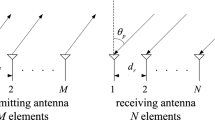Abstract
Passive bistatic radar belongs to passive radar systems and is a variant of bistatic radar that exploit non-cooperative‘illuminators of opportunity’ as their sources of radar transmission. Passive bistatic radar has a lot of advantages such as double-base system, silent acceptance, inherently low cost and so on, and hence attractive for a broad range of applications in recent years. The Passive GNSS-Based bistatic Radar system exploits Global Navigation Satellite System as the illuminators of opportunity to detect the potential targets and is inevitable affected by multipath interference due to the reflection effect of mountains and near-earth buildings. If reference signal containing multipath interference is directly used for matching filter processing, the range-Doppler diagram will show the false target formed by matching multipath interference with echo signal. In this paper, a novel blind source separation method is proposed to recovering multipath interference from reference channel data in Passive GNSS-Based bistatic Radar. The elementary reflection matrix is used as a rotation matrix to transform the cumulant matrix to realize the purpose of diagonalization. Finally the direct wave signal and multipath interference signals were separated successfully. Both theoretical analysis and simulation result verify multipath interference can be well suppressed by the proposed method.
Access this chapter
Tax calculation will be finalised at checkout
Purchases are for personal use only
Similar content being viewed by others
References
Guo, S., Wang, J., Chen, G., Wang, J.: Method for multipath interference restraint of the reference channel in passive bistatic radar. J. XIDIAN Uni. 45(3), 18–23 (2018)
Colone, F., Bongioanni, C., Lombardo, P.: Multifrequency integration in FM radio-based passive bistatic radar. Part I: target detection. IEEE Aerosp. Electron. Syst. Mag. 28(4), 28–39 (2013)
Colone, F., Bongioanni, C., Lombardo, P.: Multifrequency integration in FM radio-based passive bistatic radar. Part II: target detection of arrival estimation. IEEE Aerosp. Electron. Syst. Mag. 28(4), 40–47 (2013)
Edrich, M., Schroeder, A., Meyer, F.: Design and performance evaluation of a mature FM/DAB/DVB-T multi-illuminator passive radar system. IET Radar Sonar Navig. 8(2), 114–122 (2014)
Howland, P.E.: Editorial: passive radar systems. IEE Proc. Radar Sonar Navig. 152(3), 105–106 (2005)
Griffiths, H.D., Baker, C.J.: Passive coherent location radar systems. Part 1: Performance predication. IEE Proc. Radar Sonar Navig. 152(3), 153–159 (2005)
Poulin, D.: Passive detection using digital broadcasters (DAB, DVB) with COFDM modulation. IEE Proc. Radar Sonar Navig. 152(3), 143–152 (2005)
Howland, P.E., Maksimiuk, D., Reitsma, G.: FM radio base d bistatic radar. IEE Proc. Radar Sonar Navig. 152, 107–115 (2005)
Nordwall, B.D.: Silent Sentry-A New Type of Radar. Aviation Week & Space Technology (1998)
Wen, Y., Sun, W., Shang, S.: Weak signal extraction based on blind source separation in passive radar. In: 2019 International Symposium on Signal Processing, pp. 26–30 (2019)
Griffiths, H.D, Long, N.R.W: Television based bistatic radar. Radar Signal Process. 133(7), 649–657(1986)
Navstar IS-GPS-200E, Interface Specification, Science Applications International Corporation, El Segundo, CA, USA. Technical Report IRN-IS-200H-003 (2015)
Global Navigation Satellite System GLONASS Interface Control Document (Edition 5 .1), Russian Institute of Space Device Engineering, Nizhnyaya Salda, Russia (2008)
BeiDou Navigation Satellite System Signal in Space Interface Control Document, Open Service Signal (Version 2.0). China Satellite Navigation Office, Beijing, China, December 2013
Galileo Open Service, Signal in Space Interface Control Document (OS SIS ICD). European Space Agency/European GNSS, Paris, France, November 2015
Pastina, D., Santi, F., Pieralice, F.: Maritime moving target long time integration for GNSS-based passive bistatic radar. IEEE Trans. Aerosp. Electron. Syst. 54(6), 3060–3083 (2018)
Colone, F., Cardinali, R., Lombardo, P.: Cancellation of clutter and multipath in passive radar using a sequential approach. In: 2006 IEEE Conference on Radar, Verona (NY), USA, p. 7 (2006)
Tsai, P.H.E., Ebrahim, K., Lange, G., Paichard, Y., Inggs, M.: Null placement in a circular antenna array for passive coherent location systems. In: 2010 IEEE International Radar Conference, Washington, DC, USA, pp. 1140–1143 (2010)
Feng, B., Wang, T., Liu, C.: An effective CLEAN algorithm for interference cancellation and weak target detection in passive radar. In: 2013 Asia-Pacific Conference on Synthetic Aperture Radar (APSAR), vol. 5, no. 2, pp. 160–163 (2013)
Fu, W., Zhou, X., Nong, B., Li, C., Liu, J.: Blind estimation of underdetermined mixing matrix based on density measurement. Wireless Pers. Commun. 104(4), 1283–1300 (2018). https://doi.org/10.1007/s11277-018-6080-z
Li, C., Zhu, L., Xie, A., Luo, Z.: Blind separation of weak object signals against the unknown strong jamming in communication systems. Wireless Pers. Commun. 97(3), 4265–4283 (2017). https://doi.org/10.1007/s11277-017-4724-z
Mohanaprasad, K., Singh, A., Sinha, K.: Noise reduction in speech signals using adaptive independent component analysis (ICA) for hands free communication devices. Int. J. Speech Technol. 3(22), 169–177 (2019)
Liu, S., Gao, X., Qi, W.: Soft sensor modelling of propylene conversion based on a Takagi-Sugeno fuzzy neural network optimized with independent component analysis and mutual information. Trans. Inst. Measur. Control 41(3), 737–748 (2019)
Rader, C., Steinhardt, A.: Hyperbolic householder transformations. IEEE Trans. Acoust. Speech Signal Process. 34, 1589–1602 (1986). Also in the SIAM Journal on Matrix Analysis and Applications 8(4), 1–5 (1988)
Li, Y., Wei, M., Zhang, F., Zhao, J.: Real structure-preserving algorithms of Householder based Transformations for quaternion matrices. J. Comput. Appl. Math. 305, 82–91 (2016)
Author information
Authors and Affiliations
Corresponding author
Editor information
Editors and Affiliations
Rights and permissions
Copyright information
© 2021 ICST Institute for Computer Sciences, Social Informatics and Telecommunications Engineering
About this paper
Cite this paper
Wen, Y., Bai, L., Zhang, X., Shang, S., Song, D., Guo, S. (2021). Algorithm for Multipath Interference Restraint Based on Blind Source Separation in Passive GNSS-Based Bistatic Radar. In: Li, B., Li, C., Yang, M., Yan, Z., Zheng, J. (eds) IoT as a Service. IoTaaS 2020. Lecture Notes of the Institute for Computer Sciences, Social Informatics and Telecommunications Engineering, vol 346. Springer, Cham. https://doi.org/10.1007/978-3-030-67514-1_30
Download citation
DOI: https://doi.org/10.1007/978-3-030-67514-1_30
Published:
Publisher Name: Springer, Cham
Print ISBN: 978-3-030-67513-4
Online ISBN: 978-3-030-67514-1
eBook Packages: Computer ScienceComputer Science (R0)




